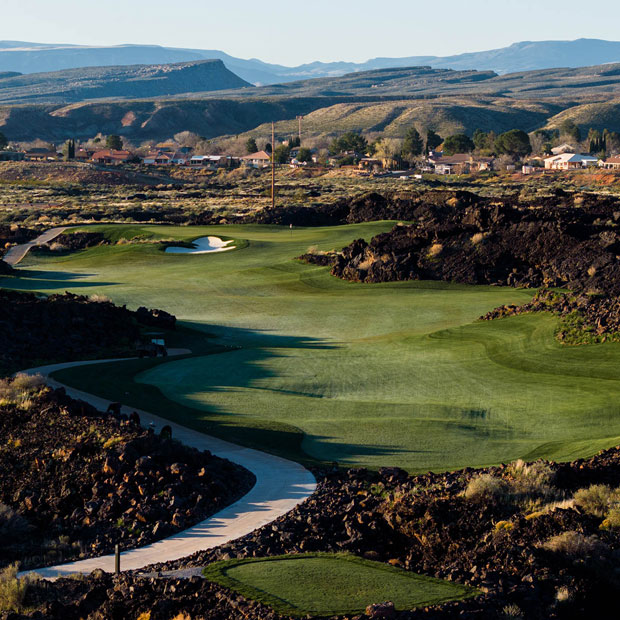Bar Run
Built on a former sand-and-gravel mine, Dan Hixson’s Bar Run compensates for its lack of compelling natural topography with quirk and strategic design

In 1965, the Guido family established a mining operation called Umpqua Sand & Gravel on a site nestled into a bend of the South Umpqua River outside of Roseburg, Oregon. As the property’s deposits dwindled, the Guidos decided on a new direction: they would transform a portion of their land into an RV resort, complete with an 18-hole golf course. They hired Oregon-based architect Dan Hixson to design the course, and site-clearing began in 2019. After the Covid-19 pandemic hit in early 2020, Hixson and lead shaper Norbert Painter had to slow their work, so construction took longer than initially anticipated. Ten holes opened for preview play in summer 2021, with the full course, named Bar Run, debuting in summer 2022. Just 6,215 yards from the back tees, Bar Run is what the Scots sometimes call a “sporting golf course”: fun, funky, and not always inclined to take itself seriously. It’s a convenient and appealing rest stop for those passing through the southern Willamette Valley on the way to or from Bandon Dunes.
{{content-block-course-profile-bar-run-001}}
Take Note…
A rarity. When I spoke with Dan Hixson last year, I wondered aloud whether Bar Run was the first affordable public golf course to open in Oregon since before the Great Recession. He guessed that the last had been his own design at Bandon Crossings in 2003.
The Hixson Trail. Like H. Chandler Egan in the 1920s and 30s, Dan Hixson has spent the past two decades gradually improving the quality of golf architecture in the Pacific Northwest. He has taken on projects of all shapes and sizes, from short-game-area redesigns to low-budget renovations to ambitious new builds. Hixson’s four high-profile original designs—Bandon Crossings, Wine Valley, the reversible course at Silvies Valley Ranch, and Bar Run—are all worth checking out, but his influence on a multitude of everyday public courses in Oregon and Washington may prove to be an equally important part of his legacy.
Baked goods. If you’re driving south to Bar Run from Portland or Eugene, stop at Creswell Bakery for a pastry or sandwich. An Oregon institution.
Concrete jungle. Since the Guidos own a concrete supply to go with their sand-and-gravel mining business, they were able to give themselves a good deal on the raw material for Bar Run’s cart paths. One unfortunate consequence of this synergy is that the cart paths are visually prominent on many holes—unfortunate, given that the course is easily walkable.
Family fun. Bar Run’s secondary attraction, catering primarily to RV guests, is a small aquatic complex featuring a lazy river. Who among us can resist a lazy river?
Local color. In a nod to the property’s former use, the Guido family has placed pieces of mining machinery (a tractor, a crane, etc.) in a few spots on the golf course, out of play but in view. A little cheesy? Sure—but also earnest and distinctive.
{{content-block-course-profile-bar-run-002}}
Favorite Hole
No. 7, par 3, 175 yards
If you were to ask 100 players to name their favorite hole at Bar Run, I feel confident that none of them would choose No. 7 (unless I were taking part in the survey, of course). Jammed into a sliver of land between the 12th hole and a boundary fence, this is unmistakably a connector par 3. Its primary purpose is to transport golfers from the “Pit”-inspired sixth green to the ravine-adjacent eighth tee without exposing them to direct bombardment from the 12th tee and fairway. Yet because of its smart design, the seventh at Bar Run is also a delight to play.
Favorite Hole
No. 7, par 3, 175 yards
If you were to ask 100 players to name their favorite hole at Bar Run, I feel confident that none of them would choose No. 7 (unless I were taking part in the survey, of course). Jammed into a sliver of land between the 12th hole and a boundary fence, this is unmistakably a connector par 3. Its primary purpose is to transport golfers from the “Pit”-inspired sixth green to the ravine-adjacent eighth tee without exposing them to direct bombardment from the 12th tee and fairway. Yet because of its smart design, the seventh at Bar Run is also a delight to play.
A less experienced architect might have overcooked this par 3, manufacturing flashy hazards and contours in an attempt to compensate for the lack of natural interest. Dan Hixson, wisely, opted for subtler moves: he built a single chocolate drop 20 yards short of the green and a Biarritz-like trough through the back-middle portion of the bunker-less, angled putting surface. These two features combine to present a beguiling challenge. With the mound partially obscuring the target and interfering with the player’s perception of distance, finding the right section of the green—front, back, or middle—requires precision and local knowledge. Different shots, from runners to pure aerial attacks, work for different pin positions.
The tee design here is worth a special note. Partly to make room for the 12th fairway, the teeing ground for No. 7 is a narrow ribbon pressed against the fence. Cleverly, though, it sits on a diagonal relative to the line of play. This means that the front tees offer a different, and friendlier, angle than the back tees do. It’s a savvy ploy—one that David McLay Kidd often uses on his par 3s as well.

{{content-block-course-profile-bar-run-003}}
Overall Thoughts
I wish it were more common for a golf architect to go into a project with the knowledge that the end result won’t be a top-100 masterpiece. That mindset can be liberating.
For example, when Dan Hixson first toured the Guido family’s depleted sand-and-gravel mine, I’m sure he knew he wouldn’t be able to build Oregon’s greatest golf course on it. The land had been damaged by decades of industry. While the section of the site closest to the South Umpqua River was relatively intact, with mature trees and subtle undulation, the rest of the property had been mined into a collection of rectangular ponds. This was a reclamation job, and the budget was nowhere near Shadow Creek proportions.
Yet the project’s limited potential seems to have freed Hixson up. More than any of his previous original designs, Bar Run is experimental and whimsical. The greens and their surrounds are riven by unpredictable contours, alternately wavy and jagged. Several holes feature angular mounds that suggest both the sharp edges of the site’s industrial elements and the outlines of the surrounding mountain ranges. The course’s single boldest hole, the par-4 sixth, imitates the famous “Pit” hole at North Berwick, but instead of playing over an ancient, crumbling property enclosure, Bar Run’s version boasts a new wall constructed out of materials provided by the Guido family’s own concrete service. Strategically, it’s a decent match for the original, though some may be bothered by its artificiality. (I think it’s enjoyably strange.)
{{content-block-course-profile-bar-run-004}}
Whether you find such quirks entertaining or off-putting, the rationale behind them is clear. Bar Run is not trying to be the Citizen Kane of golf courses. Its ambitions are more along the lines of Ferris Bueller’s Day Off: rewatchable (or replayable), if less likely to impress the panelists of the Sight & Sound (or Golf Magazine) ranking.
What makes Bar Run’s eccentricity work, though, is an underpinning of real craftsmanship. Each of the course’s six par 3s is distinct and memorable, particularly the short 11th, with its 50-yard-long, 12-yard-wide green, and the punchbowl 15th, which plays like a scaled-down version of Sand Valley’s 17th. As these holes demonstrate, Hixson’s greatest strength as an architect is green design. All of Bar Run’s greens are unique without being kooky, and they flow out of and back into the flattish terrain with a casual naturalness that only skilled designers and shapers can achieve.
My main disappointment with Bar Run is that it doesn’t seem totally committed to its more daring concepts. The chocolate-drop-style mounding on some holes is not carried consistently throughout the course, nor is the elaborate shaping of the large bunkers on Nos. 1, 14, and 15. As a result, some parts of the course feel unfinished. Take the fourth and fifth holes, which are oddly bland and unfocused; or the small, egg-shaped green-side bunkers on Nos. 9, 10, 11, 16, and 18, which feel like afterthoughts, especially in contrast to the lovingly crafted contours of the greens themselves.
I suspect, however, that most golfers will forgive these weaknesses. Bar Run is a welcome addition to the Oregon public golf, offering a laid-back atmosphere, inventive architecture, and a sporting challenge for a sub-$100 green fee. More of this, please.
0 Eggs
Bar Run is still a baby. If the course improves as it matures, and especially if Hixson works with the Guido family to tie up some of the architectural loose ends, I could see it earning an Egg in the future.
Make no mistake, Bar Run is a very good and enjoyable golf course, eminently worth seeking out if you’re in the area. Just because your favorite local food truck isn’t Michelin-starred doesn’t mean there’s anywhere better to get a banh mi sandwich on a Friday evening after a long week at work.
Course Tour

{{content-block-course-profile-bar-run-005}}
Leave a comment or start a discussion
Get full access to exclusive benefits from Fried Egg Golf
- Member-only content
- Community discussions forums
- Member-only experiences and early access to events









Leave a comment or start a discussion
Lorem ipsum dolor sit amet, consectetur adipiscing elit. Suspendisse varius enim in eros elementum tristique. Duis cursus, mi quis viverra ornare, eros dolor interdum nulla, ut commodo diam libero vitae erat. Aenean faucibus nibh et justo cursus id rutrum lorem imperdiet. Nunc ut sem vitae risus tristique posuere. uis cursus, mi quis viverra ornare, eros dolor interdum nulla, ut commodo diam libero vitae erat. Aenean faucibus nibh et justo cursus id rutrum lorem imperdiet. Nunc ut sem vitae risus tristique posuere.